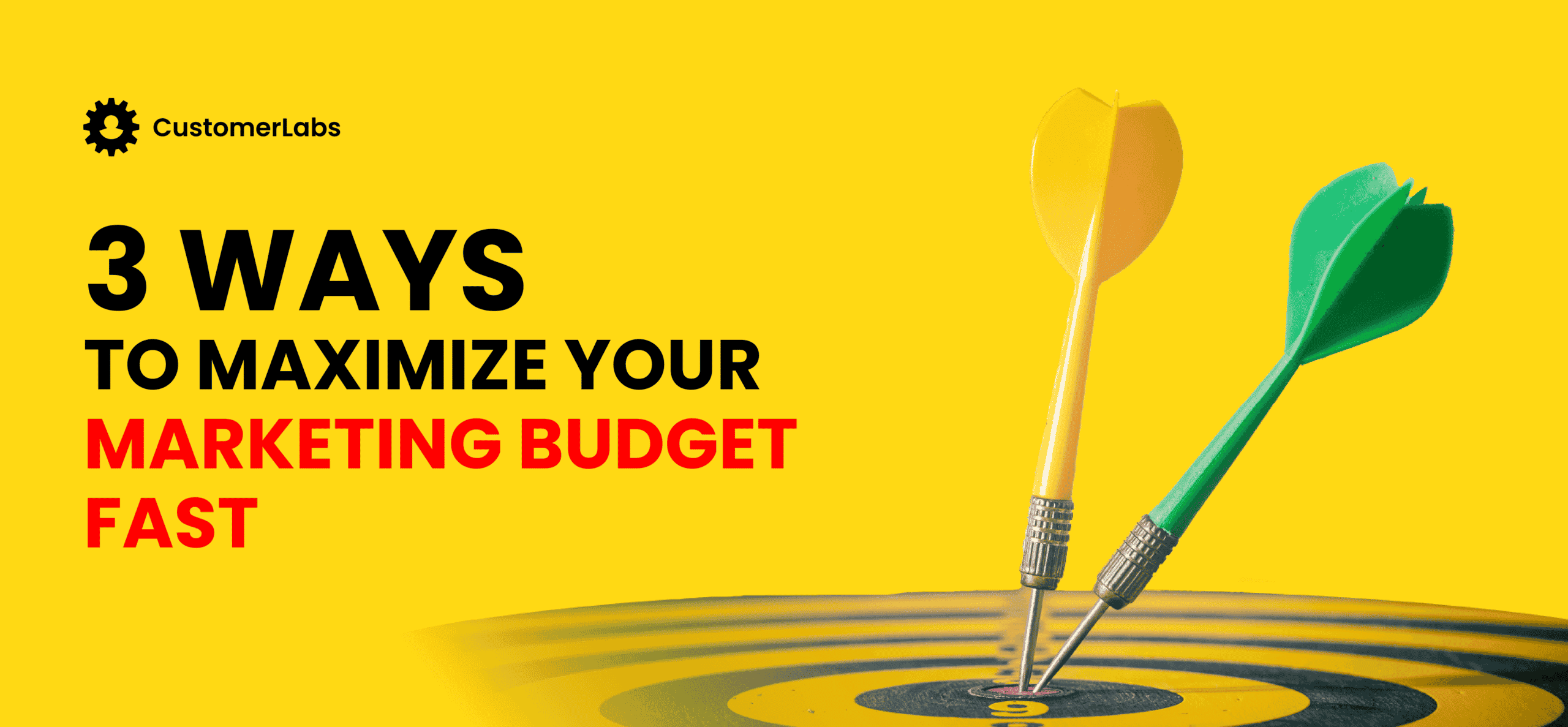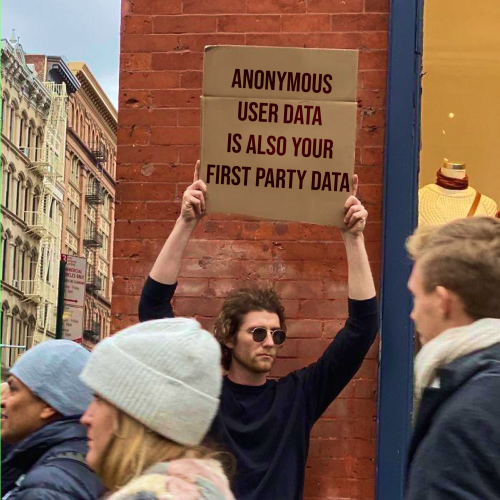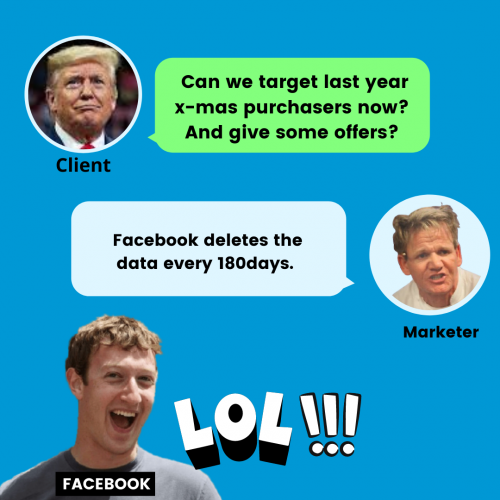
The typical campaign structure
While speaking with many digital marketers there’s a strong belief that the campaign structure should split into Top funnel and Bottom funnel campaigns.
Top funnel campaigns are focused on age groups, demographics, and interests powered by third-party data i.e. ad platforms majorly.
For bottom-funnel campaigns, they try to run a series of retargeting ads to convert those who abandoned the cart and checkout pages for the next 7-21 days.
Most E-commerce companies are aiming at converting 2% of the visitors as purchasers and it is considered to be a great conversion metric.
But what happens to the remaining 98% who did not buy?

98% of your customers are stuck in the middle – Welcome to the messy middle
As discussed the obsession on the top and the bottom of the funnel, the middle is always overlooked.
Primarily because there is an assumption among the marketers that
the re-targeting ad campaigns work only between 7-21 days and they find that the campaign performance drops after a certain period.
Why does campaign performance drop after 21days?
We spend the whole night deciding what to binge on Netflix and you give 7days to make a purchase decision for a piece of jewelry or denim or gadgets. That’s just not fair.
A user who engaged with you through an ad or organic search follows a loop of exploration and evaluation before making the purchase decision.

These users are the high-intent audience who is aware that they are in need and want to be served. When these users are nurtured rightly with the relevant content, they can be pushed to the bottom of the funnel.
It’s re-activating and not retargeting
We fail to understand that re-targeting must be about re-activating and rekindling the intent of the user again and approaching these high-intent audiences at the right time.
And we need to start thinking beyond the 21 days window.
Usually, a marketing funnel looks like the top of the funnel (awareness), middle of the funnel( product details page views), and bottom of the funnel(add to cart, initiate checkout).

In this funnel, the focus of the marketer always goes on the top of the funnel and then the add to cart to convert them into purchasers. But we forget/overlook the middle of the funnel audience who are already shown intent who can be pushed.
To push these users from the middle to the bottom of the funnel, we need to understand how to influence the user that will help them make a decision.
Understand the user before firing ads
A user who is stuck in a loop needs validation to make a decision. Let’s say there is a user who wishlisted ripped denim. Now, this user can be nurtured with ;
- personalized and engaging content unlike the regular generic ads,
- other types of denim,
- some 10-15% offers,
- create the urgency to purchase
- and more reviews on the related products can help the user make a decision.
Similarly, if a user has added_to_cart/wishlisted but has not purchased for more than 3-4 months, then, these audiences can be re-activated by not the regular ads but with any first-time discount coupons or try experimenting with other influential factors that will help the user make a decision.
Re-activating your mid-funnel audience
Obviously, to engage the mid-funnel audience we’d need to rely on the ad-platforms as many of those are anonymous visitors. This data is in Facebook’s pixel or Google Analytics which you had been sending over to it for a while.
- Hoping to engage the audience, we’d be creating a custom audience on Facebook of the users who engaged and showed intent with the website in the last two months.
But, Facebook hit us really hard with audience match rates
Facebook could match less than 25% of the total audience for us to re-engage (which is an open secret that Facebook audience match rate sucks).

First-Party Data to win the mess – “Two arrows in one bow ”
➡️ You need first-party data to re-activate these users – i.e. anonymous data.
It’s unfair to not talk about anonymous visitors when reactivating the middle of the funnel.
Not that CRM data and the forms submitted are only first-party data. Generally, 80% of the website visitors are anonymous.
These anonymous visitors who may have gone through the product details and left the site are also our first-party data.

Your middle funnel users may not have submitted forms but we still have their browser ID, click ID, IP address, user agent, Facebook ID, and Google ID.
➡️ You need first-party data for the amazing Facebook audience match rate
The Facebook custom audience match rate is low because of the iOS’14 update as the users have the choice to opt-out of tracking. And also GDPR and CCPA’s amended laws and regulations on privacy and security.
Nevertheless, we also have Google announced that by 2023, they will phase out 3rd party cookies from chrome.
Having said that, we wanted to share the audience match rate of our clients in comparison to the Facebook audience manager to prove that First-Party data is the best available solution.
Facebook pixel data vs First-party data
One of our E-commerce clients created a custom audience list of the website visitors for the last 90days and we have the first-party data collected of these visitors. The total audience size is 2+ Million.
When they synced their first-party anonymous data, the custom audience match rate achieved is more than 80% using first-party data whereas the Facebook audience match rate is less than 30%.
![]()
We should start collecting our rich first-party data of both known and anonymous users with which we will be able to achieve an unbelievable match rate. Check out if you want to read more on how we achieved a custom audience match rate beyond 80%.
Now, we understand that the issue isn’t a temporary glitch that will fix itself in a month or so. The change is permanent and expected to evolve keeping privacy the center of attention. And we need to fix the root of the problem for the cookieless future tomorrow.
Needless to say, the solution is first-party data as we need to have complete control over the data to understand the users and strategize accordingly.
Strategies to activate your messy middle using First-Party Data
With an 80% match rate using your first-party data, you can strategize in various ways:
➡️ Increase your conversions from the middle of the funnel
Create Segments: You can create as many segments as you want and run personalized ad campaigns like email campaigns.
For example, you can not only send emails but also show ads to the user who was waiting for an XL T-shirt to be restocked like email campaigning.
➡️ Bring the x-mas and easter purchasers back to the funnel
No more 180 days retention story:

When using tools like CDP, there is no retention fear for marketers at all. And therefore, you can bring in the x-mas purchasers again back to the funnel.
For example, if Charlie has purchased a cake for the X-mas on 20th Dec 2020, and now, you can re-warm and re-activate the funnel and tell “It’s Xmas time, we are ready to serve you again”.
Apparently, it is x-mas in a month. Yayy!!
➡️ Split your budget / Budget allocation
You can experiment by splitting your budget and allocating a 10-15% on your middle of the funnel. Your middle of the funnel is the ideal ICPs for your business. Experimenting and trials can produce great results.
For example, if you’ve 100K visitors and around 2000 converts, we can now strategize to activate the remaining 98000. With smaller segments, we can achieve smart personalization as well (like people who are interested in red shirts, 10-inch shoes, etc).
Summary:
To all the marketers who have skipped the 4minutes read, here is a quick take-away.
It seems to be like every marketer is happy about the 2% conversion rate and does not really care about the remaining 98% of the users who are still in the funnel.
And the ignorance over the 98% of mid-funnel users is primarily because there is an assumption among the marketers that the re-targeting ad campaigns work only between 7-21 days and they find that the campaign performance drops after a certain period.
In today’s world of options and choices, the users are stuck in the loop of exploring more and evaluating the best. And 7days’ deadlines to make the decision of purchase is surely a nightmare.
However, these users stuck in the middle are our high-intent audience who is already in need and want to be served. A nudge with the proper understanding of the user would push them to the bottom of the funnel, unlike just throwing generic ads.
We shall use the influential factors to help the user make the decision. It can be either creating urgency or exclusive offers or providing social proof, etc. But to re-activate these mid-funnel users, we neither have a Facebook audience match rate nor anonymous user data as 80% of the website visitors are anonymous.
To serve both the needs in a single deed is First-Party data. Given the situation of privacy and security, we need to start collecting the first party which is anonymous user data, and also for improving the Facebook audience match rate.
Going forward, we are compelled to collect our own first-party data and experiment with our marketing strategies with rich and accurate data.



